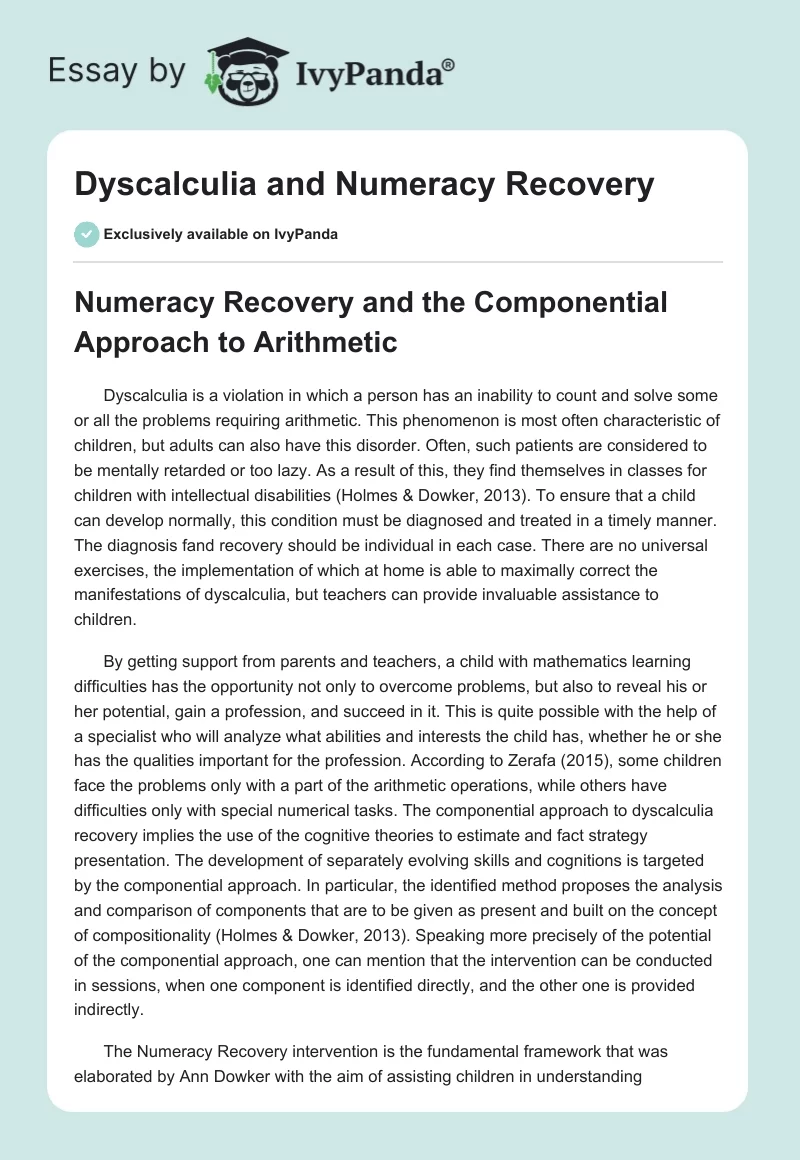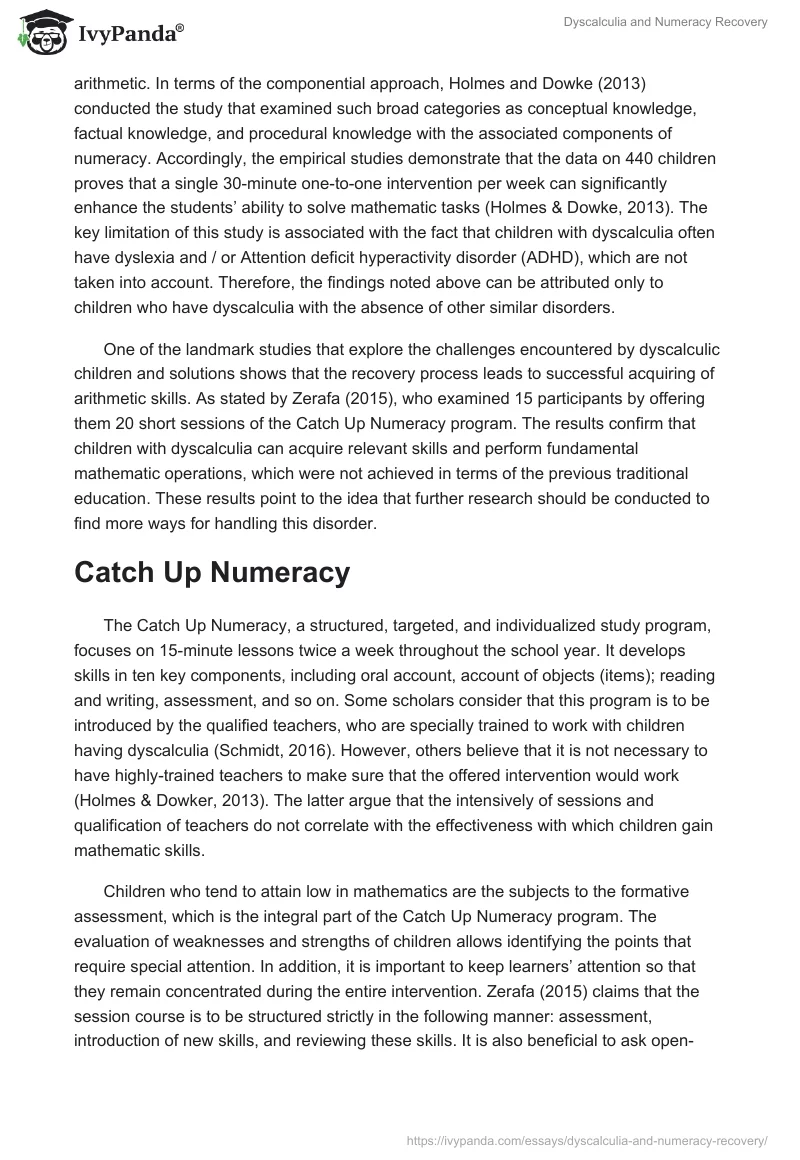Numeracy Recovery and the Componential Approach to Arithmetic
Dyscalculia is a violation in which a person has an inability to count and solve some or all the problems requiring arithmetic. This phenomenon is most often characteristic of children, but adults can also have this disorder. Often, such patients are considered to be mentally retarded or too lazy. As a result of this, they find themselves in classes for children with intellectual disabilities (Holmes & Dowker, 2013). To ensure that a child can develop normally, this condition must be diagnosed and treated in a timely manner. The diagnosis fand recovery should be individual in each case. There are no universal exercises, the implementation of which at home is able to maximally correct the manifestations of dyscalculia, but teachers can provide invaluable assistance to children.
By getting support from parents and teachers, a child with mathematics learning difficulties has the opportunity not only to overcome problems, but also to reveal his or her potential, gain a profession, and succeed in it. This is quite possible with the help of a specialist who will analyze what abilities and interests the child has, whether he or she has the qualities important for the profession. According to Zerafa (2015), some children face the problems only with a part of the arithmetic operations, while others have difficulties only with special numerical tasks. The componential approach to dyscalculia recovery implies the use of the cognitive theories to estimate and fact strategy presentation. The development of separately evolving skills and cognitions is targeted by the componential approach. In particular, the identified method proposes the analysis and comparison of components that are to be given as present and built on the concept of compositionality (Holmes & Dowker, 2013). Speaking more precisely of the potential of the componential approach, one can mention that the intervention can be conducted in sessions, when one component is identified directly, and the other one is provided indirectly.
The Numeracy Recovery intervention is the fundamental framework that was elaborated by Ann Dowker with the aim of assisting children in understanding arithmetic. In terms of the componential approach, Holmes and Dowke (2013) conducted the study that examined such broad categories as conceptual knowledge, factual knowledge, and procedural knowledge with the associated components of numeracy. Accordingly, the empirical studies demonstrate that the data on 440 children proves that a single 30-minute one-to-one intervention per week can significantly enhance the students’ ability to solve mathematic tasks (Holmes & Dowke, 2013). The key limitation of this study is associated with the fact that children with dyscalculia often have dyslexia and / or Attention deficit hyperactivity disorder (ADHD), which are not taken into account. Therefore, the findings noted above can be attributed only to children who have dyscalculia with the absence of other similar disorders.
One of the landmark studies that explore the challenges encountered by dyscalculic children and solutions shows that the recovery process leads to successful acquiring of arithmetic skills. As stated by Zerafa (2015), who examined 15 participants by offering them 20 short sessions of the Catch Up Numeracy program. The results confirm that children with dyscalculia can acquire relevant skills and perform fundamental mathematic operations, which were not achieved in terms of the previous traditional education. These results point to the idea that further research should be conducted to find more ways for handling this disorder.
Catch Up Numeracy
The Catch Up Numeracy, a structured, targeted, and individualized study program, focuses on 15-minute lessons twice a week throughout the school year. It develops skills in ten key components, including oral account, account of objects (items); reading and writing, assessment, and so on. Some scholars consider that this program is to be introduced by the qualified teachers, who are specially trained to work with children having dyscalculia (Schmidt, 2016). However, others believe that it is not necessary to have highly-trained teachers to make sure that the offered intervention would work (Holmes & Dowker, 2013). The latter argue that the intensively of sessions and qualification of teachers do not correlate with the effectiveness with which children gain mathematic skills.
Children who tend to attain low in mathematics are the subjects to the formative assessment, which is the integral part of the Catch Up Numeracy program. The evaluation of weaknesses and strengths of children allows identifying the points that require special attention. In addition, it is important to keep learners’ attention so that they remain concentrated during the entire intervention. Zerafa (2015) claims that the session course is to be structured strictly in the following manner: assessment, introduction of new skills, and reviewing these skills. It is also beneficial to ask open-ended questions and address the comments of pupils of they appear during or after the intervention. The follow-up tasks can also be included within the subsequent sessions.
With a certain degree of certainty, Holmes and Dowker (2013) state that the game format is effective for transforming atypical brain activity time and localization, into the typical activation. It means that the optimization of the educational process in these disorders is possible by activating the reserve capacities of the brain. As one of these optimization methods, the authors discuss the method of the Catch Up Numeracy program in the period of primary education (Holmes & Dowker, 2013). Among the benefits of this program, it is possible to expect less reliance on finger counting and greater efficiency in counting in general. In particular, Zerafa (2015) clarifies that children are likely to cope with summing subtraction faster, as reported by the students. The affective domain is another area that represents the positive impact of the Catch Up Numeracy program. Also, the mistakes with the incorrect writing of numbers tend to become fewer.
Implications and Constraints for the Catch up Numeracy Program
The difficulties children face with mathematics are often associated with the high level of anxiety. Devine, Hill, Carey, and Szűcs (2018) emphasize that the female students are more likely to develop anxiety when they encounter problems with calculation of numbers compared to male students. These authors maker an assumption that poor arithmetic performance correlates with anxiety , which is largely caused by emotional and cognitive issues. According to Devine et al. (2018), “results suggest that cognitive deficits (DD) mostly exist in the absence of emotional problems (MA) and vice versa and likely require quite different types of interventions” (p. 440). As for the implementation of the Catch up Numeracy program, it is clear that its use is much more effective compared to the traditional efforts to improve mathematic skills of children. Which are usually applied in schools. Instead, it is critical to evoke positive perception of arithmetic since the studies show that children lacking anxiety are more likely to learn how to work with calculations. By mitigating the development of worry in children, it is possible to promote their self-contro9l and conscientiousness.
The constraints of the Catch up Numeracy program refer to the unexplored nature of this intervention. Little attention is paid to the problem of dyscalculia in general compared to dyslexia and other related disorders. The majority of the studies specifically target only dyscalculia while it can also have some comorbid conditions, the impact of which cannot be underestimated (Schmidt, 2016). More to the point, the research methods need to be adjusted to ensure that children’s performance in the course of sessions is assessed properly. Nevertheless, the current evidence reviewed in this paper is promising of future improvements, and the context-oriented approach seems to be one of the most substantial areas to explore.
By highlighting the heterogeneity of dyscalculia as its inherent property, the authors write that individual differences should be discussed with a clear definition of their symptoms. The assumptions of a single deficit mechanism are not supported by the observed range of clinical manifestations of dyslexia. Dyscalculia and other mathematical difficulties can also be supported by environmental factors classified as cultural – the nature and degree of school education or characteristics of the counting system. It follows that today one can clearly imagine the scale of difficulties with teaching mathematics and the distribution of these difficulties into those that cannot be corrected and prevented. In turn, it is extremely important in educational theory and practice to establish and implement the ways to help children with dyscalculia.
References
Devine, A., Hill, F., Carey, E., & Szűcs, D. (2018). Cognitive and emotional math problems largely dissociate: Prevalence of developmental dyscalculia and mathematics anxiety. Journal of Educational Psychology, 110(3), 431-444.
Holmes, W., & Dowker, A. (2013). Catch up numeracy: A targeted intervention for children who are low-attaining in mathematics. Research in Mathematics Education, 15(3), 249-265.
Schmidt, M. C. S. (2016). Dyscalculia≠ maths difficulties. An analysis of conflicting positions at a time that calls for inclusive practices. European Journal of Special Needs Education, 31(3), 407-421.
Zerafa, E. (2015). Helping children with dyscalculia: a teaching programme with three primary school children. Procedia-Social and Behavioral Sciences, 191, 1178-1182.


